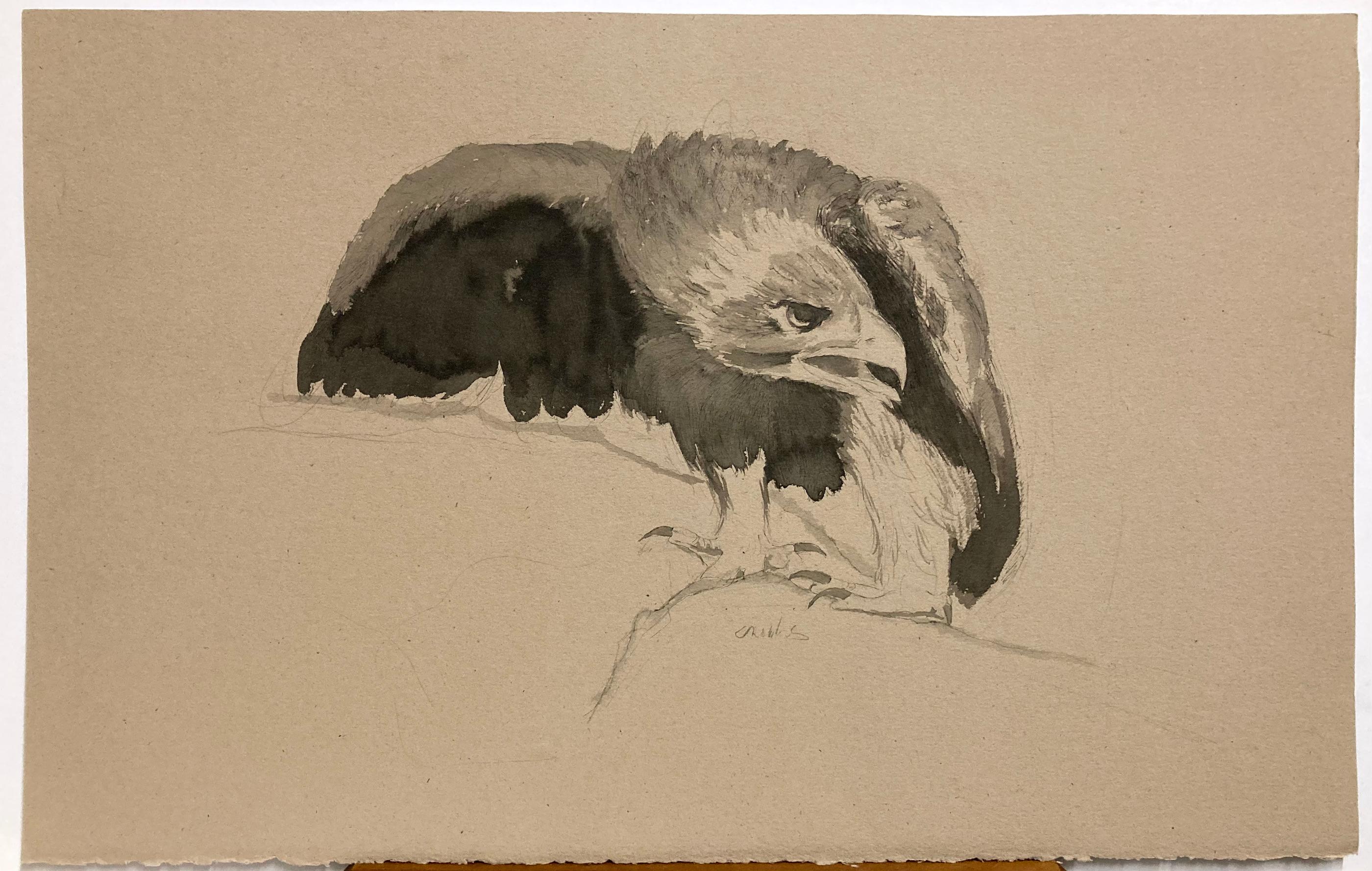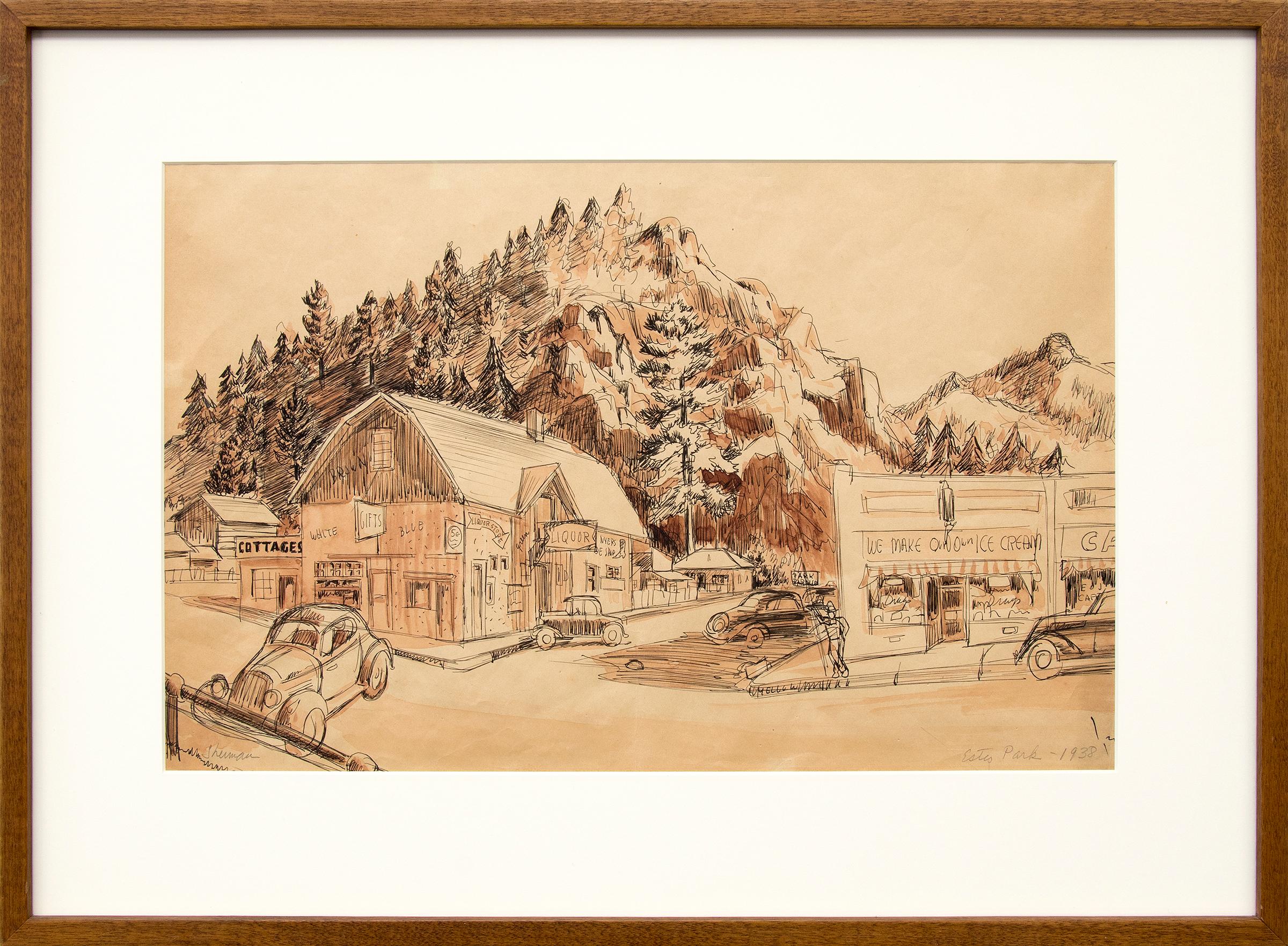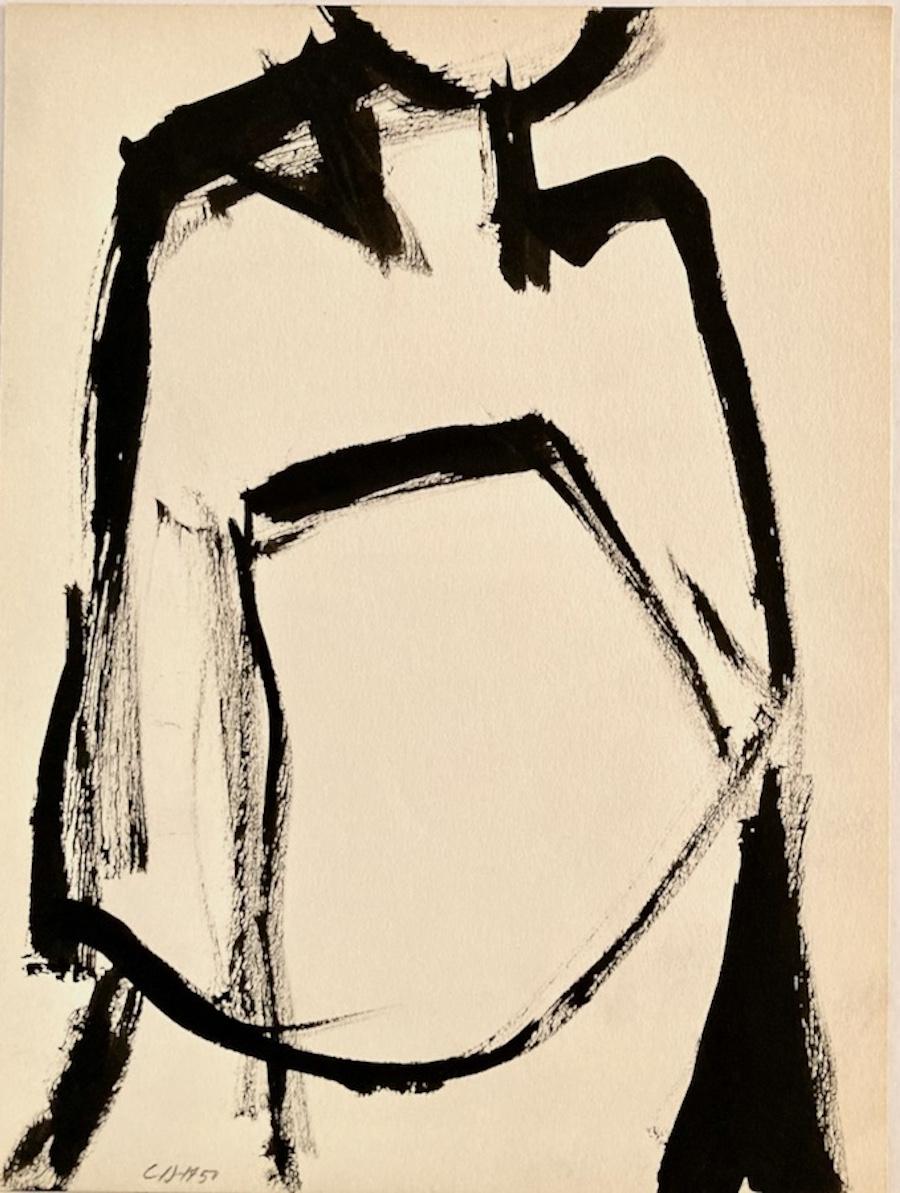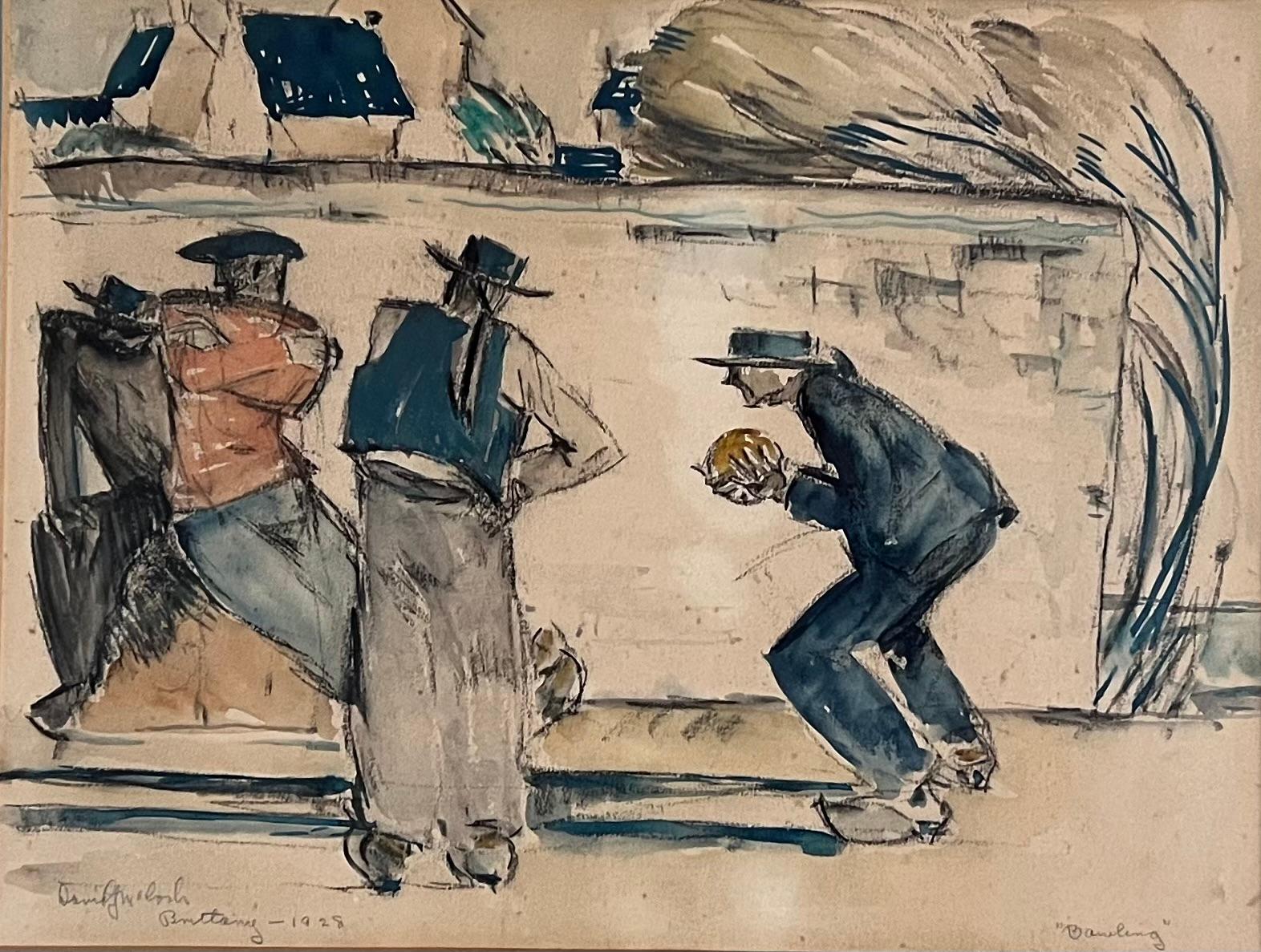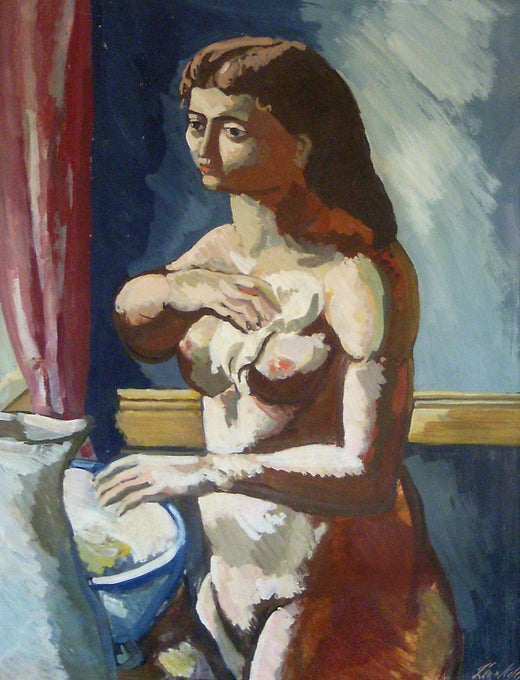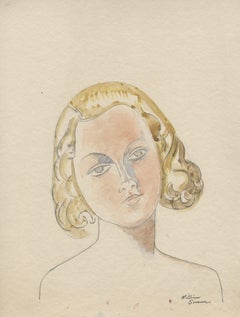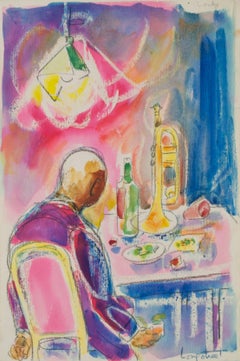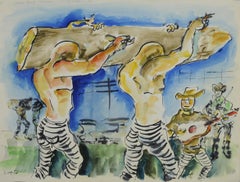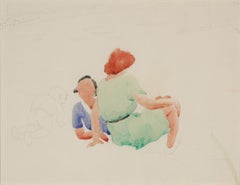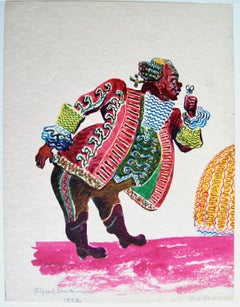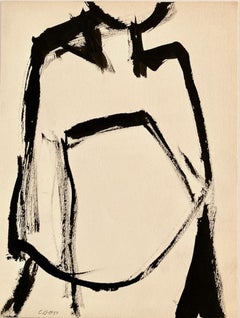Items Similar to Two Studies of Henriette (Head of the artist's wife & The Artist's wife writing
Want more images or videos?
Request additional images or videos from the seller
1 of 7
Leon KellyTwo Studies of Henriette (Head of the artist's wife & The Artist's wife writing1928-1930
1928-1930
About the Item
Two Studies of Henriette (Left: Head of the artist's wife, Right: The Artist's wife writing a letter)
Watercolor and graphite on paper, 1928-1930
Signed in pencil lower right (see photo)
Image/sheet size: 9 3/8 x 11 inches
Condition: Excellent
Colors fresh and unfaded
Provenance: Estate of the artist
The Orange Chicken
The influence of Renoir is seen in the study of the head of Henriette, and the strong influence of Bonnard is seen in the vignette of Henriette writing a letter.
Kelly was influenced by the art collection of this patron Albert Barnes, the famous collector
Leon Kelly (From Wikipedia, the free encyclopedia)
Leon Kelly (October 21, 1901 – June 28, 1982) was an American artist born in Philadelphia, PA. He is most well known for his contributions to American Surrealism, but his work also encompassed styles such as Cubism, Social Realism, and Abstraction. Reclusive by nature, a character trait that became more exaggerated in the 1940s and later, Kelly's work reflects his determination not to be limited by the trends of his time. His large output of paintings is complemented by a prolific number of drawings that span his career of 50 years. Some of the collections where his work is represented are: The Metropolitan Museum in New York, The Whitney Museum of American Art, the Museum of Modern Art, the Philadelphia Museum of Art, and Boston Public Library.
Biography
Kelly was born in 1901 at home at 1533 Newkirk Street, Philadelphia, PA. He was the only child of Elizabeth (née Stevenson) and Pantaleon L. Kelly. The family resided in Philadelphia where Pantaleon and two of his cousins owned Kelly Brothers, a successful tailoring business. The prosperity of the firm enabled his father to purchase a 144-acre farm in Bucks County PA in 1902, which he named "Rural Retreat" It was here that Pantaleon took Leon to spend every weekend away from the pressures of business and from the disappointments in his failing marriage. Idyllic and peaceful memories of the farm stayed with Leon and embued his work with a love of nature that emerged later in the Lunar Series, in Return and Departure, and in the insect imagery of his Surrealist work. "If anything," he once said,"I am a Pantheist and see a spirit in everything, the grass, the rocks, everything."
At thirteen, Leon left school and began private painting lessons with Albert Jean Adolphe, a teacher at the School of Industrial Art (now the University of the Arts) in Philadelphia. He learned technique by copying the works of the old masters and visiting the Philadelphia Zoo, where he would draw animals. Drawings done in 1916 and 1917 of elephants, snakes and antelope, as well as copies of old master paintings by Holbein and Michelangelo, heralded an impressive emerging talent. In 1917, he studied sculpture with Alexander Portnoff but his studies came to an abrupt halt with the start of World War I. Being too young to enlist, he joined the Quartermaster Corp at the Army Depot in Philadelphia, where he served for more than a year loading ships with supplies and, along with other artists, working on drawings for camouflage.
By 1920, the family's fortunes drastically changed. His father's business had failed due to the introduction of ready made clothing and his marriage, unhappy from the beginning, dissolved. Broken by circumstance Pantaleon left Philadelphia to begin a wandering existence looking for work leaving Leon to support his mother and grandmother. He found a job in 1920 at the Freihofer Baking Company where he worked nights for the next four years. Under these circumstances Leon continued to develop his skills in drawing and painting and learned of the revolutionary developments in art that were taking place in Paris.
During the day he was granted permission to study anatomy at the Philadelphia School of Osteopathy where he dissected a cadaver and perfected his knowledge of the human figure. He also met and studied etching with Earl Horter, a well known illustrator, who had amassed a significant collection of modern art which included work by Brancusi, Matisse, and Cubist works by Picasso and Braque. Among the artists around Horter was Arthur Carles, a charismatic and controversial painter who taught at the Pennsylvania Academy of Fine Arts. Leon enrolled in the Academy in 1922, becoming what Carles described as, "his best student".
In the next three years Leon work ranged from academic studies of plaster casts, to pointillism, to landscapes of Fairmount Park in Philadelphia, as well as a series of pastels showing influences from Matisse to Picasso. Clearly influenced by Earl Horter's collection and Arthur Carles he mastered analytical cubism in works such as The Three Pears, 1923 and 1925 experimented with Purism in Moon Behind the Italian House. In 1925 Kelly was awarded a Cresson Scholarship and on June 14 he left for Europe.
Paris
The first trip to Europe lasted for approximately three and a half months and introduced Kelly to a culture and place where he felt he belonged. Though he returned to the Academy in the Fall, he left for Europe again a few months later to begin a four-year stay in Paris. He moved into an apartment at 19 rue Daguerre in Paris and began an existence intellectually rich but in creature comforts, very poor. "I kept a cinderblock over the drain in the kitchen sink to keep the rats out of the apartment" he once explained. He frequented the cafes making acquaintances with Henry Miller, James Joyce and the critic Félix Fénéon as well as others. His days were split between copying old master paintings in the Louvre and pursuing modernist ideas that were swirling through the work of all the artists around him. The Lake, 1926 and Interior of the Studio, 1927, now in the Newark Museum.
Patrons during this time were the police official Leon Zamaran, a collector of Courbets, Lautrecs and others, who began collecting Kelly's work. Another was Alfred Barnes of the Barnes Collection in Philadelphia.
In 1929 Kelly married a young French woman, Henriette D'Erfurth. She appears frequently in paintings and drawings done between 1928 and the early 1930s.
Philadelphia
The stock market crash of 1929 made it impossible to continue living in Paris and Kelly and Henriette returned to Philadelphia in 1930. He rented a studio on Thompson Street and began working and participating in shows in the city's galleries. Work from 1930 to 1940 showed continuing influences and experimentation with the themes and techniques acquired in Paris as well as a brief foray into Social Realism. The Little Gallery of Contemporary Art purchased the Absinthe Drinker in 1931 and in 1932 exhibited Judgement of Paris, 1932, an ambitious painting with a classical theme. In October 1934, "Interior of a Slaughter House" and several other works were included in "Second Regional Exhibition of Painting and Prints by Philadelphia Artists" at the Whitney Museum in New York.
Kelly joined the Philadelphia Public Works of Art Project and worked on sketches for a mural destined for the School Administration Building. While some sketches survived, one is in the Metropolitan, the mural is lost. The harsh financial conditions of Kelly's life continued and by the late 1930s, Henriette, who spoke no English and whose only companionship outside the home was Helen Lloyd Horter (who spoke French), returned to France permanently When his divorce was finalized, Kelly began seeing Helen Lloyd Horter, a Philadelphia painter and a fellow student at the Academy and who was now the ex-wife of Earl Horter. In 1941 they married.
Kelly continued to work in his studio on Brandywine Street in Philadelphia teaching small classes to gain some income. Kelly's study of the masters in the Louvre collection resulted in great admiration for the Renaissance painter Leonardo Da Vinci. His influence is evident in Kelly's notebooks of this time which are full of drawings for World War II battlements and weaponry which echo DaVinci's drawings for the mechanisms of war. He also shared Leonardo's fascination with science and the underlying dynamics of how things work. His interest of the nervous system and sensory aspects of human anatomy would later come important components of his abstract figures of the 1950s and '60s.
For the complete article on Kelly, see Wikipedia
In the 1930s, he exhibited in Philadelphia and was connected with the avant-garde group aligned to the colorist Arthur Beecher Carles. Albert Barnes, the collector and patron of the arts, admired Kelly’s work and helped finance him through some difficult times. Julian Levy, a prominent art dealer in New York also took note of Kelly and showed his work in his gallery during the 1940s and 1950s.
- Creator:Leon Kelly (1901-1982, American)
- Creation Year:1928-1930
- Dimensions:Height: 9.38 in (23.83 cm)Width: 11 in (27.94 cm)
- Medium:
- Movement & Style:
- Period:
- Condition:
- Gallery Location:Fairlawn, OH
- Reference Number:Seller: FA120861stDibs: LU1409055202
Leon Kelly
Leon Kelly, born in 1901, studied at the Pennsylvania Academy of the Fine Arts, Philadelphia. Awarded a traveling scholarship from that institution in 1924, he studied in Paris, France at the Grande Chaumiere. Other teachers included Arthur B. Carles, Jean Auguste Adolphe, Earl Horter and Alexandre Portinoff. Essentially a Surrealist painter, Kelly did wide-ranging work that went from painterly to meticulous Surrealism, Cezanne-inspired watercolors, and Cubist painting. In the 1940s, Julian Levy, the Surrealist dealer, handled Kelly's work in New York City. Kelly also exhibited at the Pennsylvania Academy of the Fine Art Annuals (1933-34, 1939-46, 1966); Corcoran Gallery Biennials, Washington, D.C. (three times from 1935-47); Art Institute of Chicago, Illinois; had a 1965 retrospective exhibition at the International Gallery, Baltimore, Maryland; Long Beach, New Jersey (1968); Richard Feigen Gallery, Chicago, Illinois (1968, 1970); Newark Museum, New Jersey (1969); and the Whitney Museum of American Art, New York. Kelly's paintings are in the collections of three New York city museums, including the Metropolitan Museum of Art; Whitney Museum of American Art; and Museum of Modern Art; as well as Yale University Art Gallery, New Haven, Connecticut; Wadsworth Atheneum, Hartford, Connecticut; Pennsylvania Academy of the Fine Arts, Philadelphia; Cantor Arts Center, Stanford University, Palo Alto, California; Sara Roby Foundation Collection at the Smithsonian Institution, Washington, D.C.; Smith College Museum of Art, Northampton, Massachusetts; Sheldon Memorial Art Gallery, Lincoln, Nebraska; Newark Museum, New Jersey; and the Tel Aviv Museum, Israel.
About the Seller
5.0
Recognized Seller
These prestigious sellers are industry leaders and represent the highest echelon for item quality and design.
Platinum Seller
Premium sellers with a 4.7+ rating and 24-hour response times
Established in 1978
1stDibs seller since 2013
784 sales on 1stDibs
Typical response time: 1 hour
Associations
International Fine Print Dealers Association
- ShippingRetrieving quote...Shipping from: Fairlawn, OH
- Return Policy
Authenticity Guarantee
In the unlikely event there’s an issue with an item’s authenticity, contact us within 1 year for a full refund. DetailsMoney-Back Guarantee
If your item is not as described, is damaged in transit, or does not arrive, contact us within 7 days for a full refund. Details24-Hour Cancellation
You have a 24-hour grace period in which to reconsider your purchase, with no questions asked.Vetted Professional Sellers
Our world-class sellers must adhere to strict standards for service and quality, maintaining the integrity of our listings.Price-Match Guarantee
If you find that a seller listed the same item for a lower price elsewhere, we’ll match it.Trusted Global Delivery
Our best-in-class carrier network provides specialized shipping options worldwide, including custom delivery.More From This Seller
View AllHead of a Young Woman with Blond Hair
By William Sommer
Located in Fairlawn, OH
Head of a Young Woman with Blond Hair
Watercolor on paper mounted on rag paper support, c. 1930
Signed with the Estate Stamp B
Provenance: Estate of the Artist
...
Category
1930s American Modern Figurative Drawings and Watercolors
Materials
Watercolor
Lonly (Lonely)
By Stephen Longstreet
Located in Fairlawn, OH
Signed lower right
Provenance:
Joseph M. Erdelac, Cleveland, OH
Possibly deaccessed from the Columbus Museum of Art
THOMAS FRENCH FINE ART, LLC
Stephen Longstreet (1907-2002)
A...
Category
20th Century American Modern Figurative Drawings and Watercolors
Materials
Watercolor
Chain Gang Music
By Stephen Longstreet
Located in Fairlawn, OH
Chain Gang Music
Watercolor on paper, dated '39, but created in the 1970's
Signed "Longstreet" lower left corner
Titled and annotated "George - '39" in pencil at top of sheet
Provenance: Acquired from the artist
Joseph M. Erdelac, friend and patron of the artist
Born Henri Weiner (sometimes spelled Wiener), the artist tried alternate names and personae including Paul Haggard, Thomas Burton, and David Ormsbee before settling on the name Stephen Longstreet in 1939. Longstreet dates his art based on the period he means to represent, not the actual date of execution.
Stephen Longstreet (1907-2002)
The artist’s own grandchildren attempt to fathom the real life and nature of Stephen Longstreet, prolific author, artist, screenplay writer, and jazz aficionado.
Born Chauncy Weiner (sometimes spelled Wiener) in New York City in 1907, Longstreet reinvented himself on a regular basis. Changing his name first to “Henry,” then “Henri,” he started his career as a commercial artist for a department store. In various public biographies he claimed to have studied in New York, London, and Paris, and said he was a student of cartoonist Ralph Barton...
Category
1970s American Modern Figurative Drawings and Watercolors
Materials
Watercolor
Two Women and a Child on the Beach at Provincetown
By Charles Demuth
Located in Fairlawn, OH
Two Women and a Child on the Beach at Provincetown
Unsigned.
Watercolor on paper, c. 1934
A beautiful Provincetown beach scene, included in the catalogue raisonne.
Please see Babcoc...
Category
1930s American Modern Drawings and Watercolor Paintings
Materials
Watercolor
Girl in Profile
By William Sommer
Located in Fairlawn, OH
Girl in Profile
Lithographic crayon and watercolor on thin wove paper, c. 1930
Signed twice in pencil (see photos)
Provenance: Estate of the Artist
Edward Somme...
Category
1930s American Modern Figurative Drawings and Watercolors
Materials
Watercolor
Quick Change
By Honore Guilbeau
Located in Fairlawn, OH
Quick Change
Watercolor on paper, 1930-1931
Signed lower right: Honore Guilbeau
Illustrated in American Art Review, August 2014, page 84 in an article by Dr. M...
Category
1930s American Modern Figurative Drawings and Watercolors
Materials
Watercolor
You May Also Like
Blanche Grambs, Eagle
Located in New York, NY
Blanche Grambs, whose career started with the WPA, was an extremely skilled draftsperson.
Her birds are masterful. Here an eagle, a majestic bird-of-pr...
Category
1970s American Modern Figurative Drawings and Watercolors
Materials
Watercolor
Alfred Bendiner, Baccaloni in Rosenkavalier
By Alfred Bendiner
Located in New York, NY
The Italian opera singer, Salvatore Baccaloni (1900-1969) often took comic roles. He worked with several opera companies in Philadelphia between 1951 and 1966. Bendiner was a world t...
Category
Mid-20th Century American Modern Figurative Drawings and Watercolors
Materials
Gouache
Estes Park Colorado American Modernist Watercolor Landscape Painting, WPA 1930s
By James Russell Sherman
Located in Denver, CO
Vintage 1930s watercolor and ink painting of Estes Park, Colorado, by American artist James Russell Sherman (1906-1989). This captivating work features a detailed view of storefronts...
Category
1930s American Modern Landscape Drawings and Watercolors
Materials
Watercolor
Clinton Hill, (Nude #1), 1951, drawing, figure/abstraction
By Clinton Hill
Located in New York, NY
Clinton Hill (1922-2003), created quintessential mid-century images, but figures are unusual in his work. This is from a very early period. In 1951 Hill studied at the Academie de la...
Category
Mid-20th Century American Modern Abstract Drawings and Watercolors
Materials
Gouache
Clinton Hill, Firenze (Florence, Italy), 1952, drawing, landscape/abstraction
By Clinton Hill
Located in New York, NY
Clinton Hill (1922-2003), created quintessential mid-century images. This abstraction references Florence, Italy, where he studied in the early 1950s.
He lived in SoHo, New York, a...
Category
Mid-20th Century American Modern Landscape Drawings and Watercolors
Materials
Gouache
Bowling
Located in Los Angeles, CA
(Note: This work is part of our exhibition Connected by Creativity: WPA Era Works from the Collection of Leata and Edward Beatty Rowan)
Watercolor on paper, 7 ¾ x 10 ½ inches unframed, 14 ½ x 16 ½ inches framed, signed, dated, and located lower left as follows: “David McCosh...
Category
1920s American Modern Figurative Drawings and Watercolors
Materials
Watercolor
Recently Viewed
View AllMore Ways To Browse
The Tailor Art
Famous Artist Sketches
The Leonardo Collection
English Renaissance Painting
Memories Of Surrealism
Head Of Alexander
American Revolutionary War
Kelly Move
Renoir Drawings
Two Head Snake
Cast Plaster Head
Cubist Head
60s Figure Drawing
Old Master Mother Child
1930 Social Realism
Michelangelo Drawings
The Fortune Ship
Da Vinci Drawings
